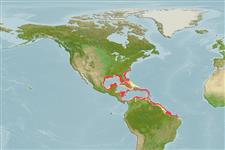Common names from other countries
Classification / Names / Names
ชื่อสามัญ | ชื่อพ้อง | Catalog of Fishes (gen., sp.) | ITIS | CoL | WoRMS
Environment: milieu / climate zone / depth range / distribution range
นิเวศวิทยา
; ระดับความลึก 0 - 141 m (Ref. 109264). Tropical; 35°N - 4°S, 94°E - 38°E (Ref. 83435)
Western Atlantic.
Length at first maturity / ขนาด / น้ำหนัก / Age
Maturity: Lm ? range ? - ? cm Max length : 5.0 cm DL เพศผู้/กระเทย; (Ref. 83435); common length : 3.8 cm TL เพศผู้/กระเทย; (Ref. 355)
Shell turbinate. Sculpture of spiral rows of beads, sometimes with small spines on whorl shoulders. Colour: tan to light brown, with patches of brown, reddish brown, and cream.
On sand and shell and coral rubble, in shallow subtidal (Ref. 355). Found in seagrass, ascidian, and algae habitats (Ref. 83934). Also known from seamounts and knolls (Ref. 3477).
Life cycle and mating behavior
วัยเจริญพันธุ์ | การสืบพันธุ์ | การวางไข่ | เซลสืบพันธ์ของเพศเมีย(ไข่) | ความดกของไข่ | ตัวอ่อน
Members of the order Patellogastropoda are mostly gonochoric and broadcast spawners. Life cycle: Embryos develop into planktonic trocophore larvae and later into juvenile veligers before becoming fully grown adults.
Leal, J.H. 2003. (Ref. 355)
IUCN Red List Status (Ref. 130435)
CITES status (Ref. 108899)
Not Evaluated
Not Evaluated
Human uses
การประมง: การค้า
| FishSource |
เครื่องมือ
ข้อมูลเพิ่มเติม
Age/SizeการเจริญเติบโตLength-weightLength-lengthสัณฐานวิทยาตัวอ่อนอุดมสมบรูณ์
แหล่งที่มาจากอินเตอร์เน็ต
Estimates based on models
Preferred temperature
(Ref.
115969): 23.5 - 28, mean 26.2 (based on 294 cells).
